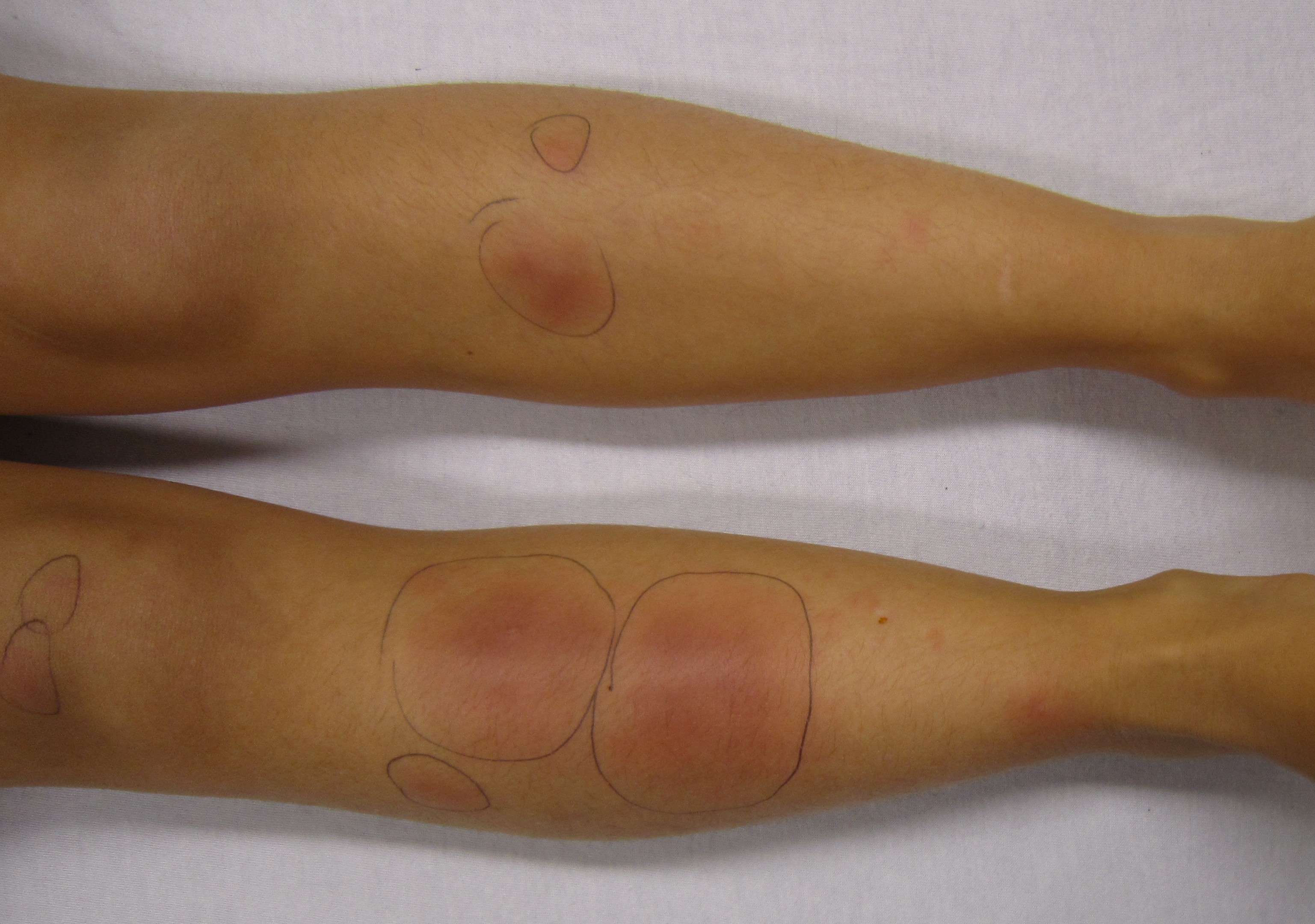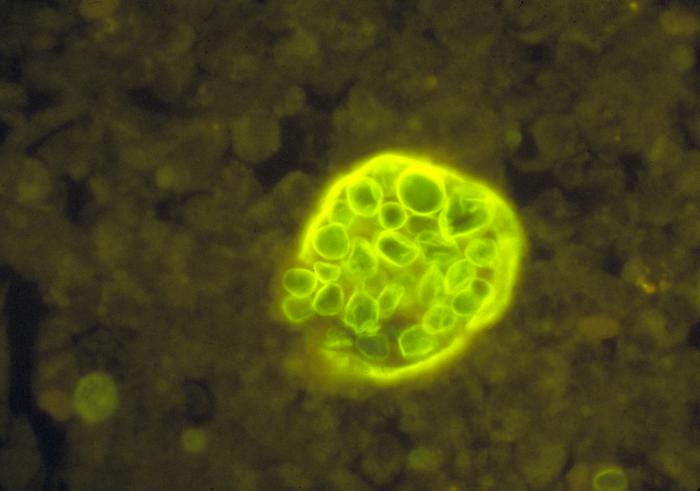WBR0188: Difference between revisions
No edit summary |
YazanDaaboul (talk | contribs) No edit summary |
||
| Line 1: | Line 1: | ||
{{WBRQuestion | {{WBRQuestion | ||
|QuestionAuthor={{Ochuko}} (Reviewed by Will Gibson) | |QuestionAuthor={{Ochuko}} (Reviewed by Will Gibson and {{YD}}) | ||
|ExamType=USMLE Step 1 | |ExamType=USMLE Step 1 | ||
|MainCategory=Microbiology | |MainCategory=Microbiology | ||
| Line 21: | Line 21: | ||
|MainCategory=Microbiology | |MainCategory=Microbiology | ||
|SubCategory=Infectious Disease | |SubCategory=Infectious Disease | ||
|Prompt=A 65-year old woman with a history of rheumatoid arthritis presents to urgent care for fatigue, myalgias, cough and fever. She reports a forty year smoking history | |Prompt=A 65-year-old woman with a history of rheumatoid arthritis presents to urgent care for fatigue, myalgias, cough, and fever. She reports a forty-year smoking history but has no otherwise remarkable past medical history. She emigrated from Mexico as a teenager and has been a migrant worker in Southern California since. Three weeks ago, her home was destroyed in an earthquake and she has been living with her son. Her temperature is 38.6 °C (101.5 °F), blood pressure is 134/86 mmHg, heart rate is 102/min, and respiratory rate is 22/min. Physical examination reveals an erythematous rash on the lower limbs (shown below). A chest radiograph reveals multiple nodules and hilar adenopathy. Which of the following is most likely to be seen on microscopic examination of a lung tissue biopsy? | ||
[[File:WBR0188prompt.jpg|400px]] | [[File:WBR0188prompt.jpg|400px]] | ||
|Explanation=The patient in this vignette has developed symptoms of systemic coccidiomycosis. | |Explanation=The patient in this vignette has developed symptoms of [[systemic coccidiomycosis]]. ''Coccidioides immitis'' is a pathogenic fungus that is endemic to the Southwestern United States. It is most often acquired through inhalation of a spore. In extremely rare cases, it can be acquired through a spore entering an open wound in the skin. The majority of individuals (60%) do not develop any symptoms of infection, but the remaining 40% tend to experience a mild pneumonia. In 5-10% of cases, patients may develop more aggressive pulmonary disease or chronic infection. These patients are often immunocompromised and sometimes develop systemic disease (1% of all patients). | ||
Pulmonary coccidiomycosis usually presents with fatigue, cough, myalgias, fever and night sweats. Most patients' symptoms will resolve without medical intervention. | Pulmonary coccidiomycosis usually presents with fatigue, cough, myalgias, fever, and night sweats. Most patients' symptoms will resolve without medical intervention. On the other hand, systemic coccidiomycosis can manifest with some of the additional symptoms observed in this patient, such as rash that is usually either erythema nodosum (as observed in this patient's physical examination) or erythema multiforme. The different systemic mycoses can be difficult to distinguish based on symptoms alone, as they all primarily cause pulmonary disease. However, several factors make ''Coccidioides immitis'' the most likely etiologic agent in this case. First, the patient comes from Southwestern United States, an endemic area of ''C. immitis''. Second, she comes to medical attention shortly following an earthquake. The incidence of coccidiomycosis tends to significantly increase following earthquakes as spores are released from the earth and inhaled. Third, the patient has rheumatoid arthritis and likely receives pharmacological therapy with immunosuppressive effects, such as methotrexate. Finally, the patient's skin rash is more is more characteristic of coccidiomycosis since it is rarer in other systemic mycoses. | ||
The diagnostic form of C. immitis in tissue is a spherule with endospores (pictured below). Treatment is only required for patients with evidence of extensive disease or immunosuppression. When treatment is required, patients should be administered either ketoconazole, fluconazole or itraconazole, all of which inhibit Lanosterol 14 α-demethylase. | |||
Treatment is only required for patients with evidence of extensive disease or immunosuppression. When treatment is required, patients should | |||
<br> | <br> | ||
<img src="http://static.wikidoc.org/3/38/WJGSystemicMycosesDist2.svg" width="400"> | <img src="http://static.wikidoc.org/3/38/WJGSystemicMycosesDist2.svg" width="400"> | ||
<br> | <br> | ||
[[Image:Cimmitis_spherule_endospores.jpg | | [[Image:Cimmitis_spherule_endospores.jpg |500px]] <sup>Histopathology of coccidioidomycosis. Spherule of Coccidioides immitis with endospores. Calcofluor stain. From Public Health Image Gallery</sup> | ||
<br> | <br> | ||
|AnswerA=Broad based budding yeast | |AnswerA=Broad-based budding yeast | ||
|AnswerAExp=Broad based budding yeast | |AnswerAExp=Broad-based budding yeast describes ''Blastomyces dermatitidis''. | ||
|AnswerB=Spherules with endospores | |AnswerB=Spherules with endospores | ||
|AnswerBExp=Spherules with endospores characteristically | |AnswerBExp=Spherules with endospores characteristically describe ''Coccidioides immitis''. | ||
|AnswerC=Septate hyphae branching dichotomously at acute angles | |AnswerC=Septate hyphae branching dichotomously at acute angles | ||
|AnswerCExp=Septate hyphae branching dichotomously at acute angles | |AnswerCExp=Septate hyphae branching dichotomously at acute angles describe ''Aspergillus fumigatus''. | ||
|AnswerD=Non septate hyphae with broad angles | |AnswerD=Non-septate hyphae with broad angles | ||
|AnswerDExp=Non septate hyphae with broad angles | |AnswerDExp=Non-septate hyphae with broad angles describe Mucor species. | ||
|AnswerE=Monomorphic encapsulated yeast | |AnswerE=Monomorphic encapsulated yeast | ||
|AnswerEExp=Monomorphic encapsulated yeast describes Cryptococcus neoformans. | |AnswerEExp=Monomorphic encapsulated yeast describes ''Cryptococcus neoformans''. | ||
|EducationalObjectives=Coccidioides immitis is a pathogenic fungus endemic to the Southwestern | |EducationalObjectives=''Coccidioides immitis'' is a pathogenic fungus endemic to the Southwestern USA that causes pulmonary disease and appears microscopically as spherules with endospores. | ||
|References=Galgiani JN, Ampel NM, Blair JE, et al. Coccidioidomycosis. Clin Infect Dis. 2005;41(9):1217-23. | |References=Galgiani JN, Ampel NM, Blair JE, et al. Coccidioidomycosis. Clin Infect Dis. 2005;41(9):1217-23.<br> | ||
Crum NF, Lederman ER, Stafford CM, et al. Coccidioidomycosis: a descriptive survey of a reemerging disease. Clinical characteristics and current controversies. Medicine. 2004;83:149-75.<br> | |||
Crum NF, Lederman ER, Stafford CM, | |||
First Aid 2014 page 146 | First Aid 2014 page 146 | ||
|RightAnswer=B | |RightAnswer=B | ||
|WBRKeyword= | |WBRKeyword=Yeast, Coccidioidomycosis, C. immitis, Coccidioides immitis, Valley fever, Southwestern USA, Pneumonia, Cough, Fever, Night sweats, | ||
|Approved=Yes | |Approved=Yes | ||
}} | }} | ||
Revision as of 17:50, 3 November 2014
| Author | [[PageAuthor::Ogheneochuko Ajari, MB.BS, MS [1] (Reviewed by Will Gibson and Yazan Daaboul, M.D.)]] |
|---|---|
| Exam Type | ExamType::USMLE Step 1 |
| Main Category | MainCategory::Microbiology |
| Sub Category | SubCategory::Infectious Disease |
| Prompt | [[Prompt::A 65-year-old woman with a history of rheumatoid arthritis presents to urgent care for fatigue, myalgias, cough, and fever. She reports a forty-year smoking history but has no otherwise remarkable past medical history. She emigrated from Mexico as a teenager and has been a migrant worker in Southern California since. Three weeks ago, her home was destroyed in an earthquake and she has been living with her son. Her temperature is 38.6 °C (101.5 °F), blood pressure is 134/86 mmHg, heart rate is 102/min, and respiratory rate is 22/min. Physical examination reveals an erythematous rash on the lower limbs (shown below). A chest radiograph reveals multiple nodules and hilar adenopathy. Which of the following is most likely to be seen on microscopic examination of a lung tissue biopsy? |
| Answer A | AnswerA::Broad-based budding yeast |
| Answer A Explanation | AnswerAExp::Broad-based budding yeast describes ''Blastomyces dermatitidis''. |
| Answer B | AnswerB::Spherules with endospores |
| Answer B Explanation | AnswerBExp::Spherules with endospores characteristically describe ''Coccidioides immitis''. |
| Answer C | AnswerC::Septate hyphae branching dichotomously at acute angles |
| Answer C Explanation | AnswerCExp::Septate hyphae branching dichotomously at acute angles describe ''Aspergillus fumigatus''. |
| Answer D | AnswerD::Non-septate hyphae with broad angles |
| Answer D Explanation | AnswerDExp::Non-septate hyphae with broad angles describe Mucor species. |
| Answer E | AnswerE::Monomorphic encapsulated yeast |
| Answer E Explanation | AnswerEExp::Monomorphic encapsulated yeast describes ''Cryptococcus neoformans''. |
| Right Answer | RightAnswer::B |
| Explanation | [[Explanation::The patient in this vignette has developed symptoms of systemic coccidiomycosis. Coccidioides immitis is a pathogenic fungus that is endemic to the Southwestern United States. It is most often acquired through inhalation of a spore. In extremely rare cases, it can be acquired through a spore entering an open wound in the skin. The majority of individuals (60%) do not develop any symptoms of infection, but the remaining 40% tend to experience a mild pneumonia. In 5-10% of cases, patients may develop more aggressive pulmonary disease or chronic infection. These patients are often immunocompromised and sometimes develop systemic disease (1% of all patients).
Pulmonary coccidiomycosis usually presents with fatigue, cough, myalgias, fever, and night sweats. Most patients' symptoms will resolve without medical intervention. On the other hand, systemic coccidiomycosis can manifest with some of the additional symptoms observed in this patient, such as rash that is usually either erythema nodosum (as observed in this patient's physical examination) or erythema multiforme. The different systemic mycoses can be difficult to distinguish based on symptoms alone, as they all primarily cause pulmonary disease. However, several factors make Coccidioides immitis the most likely etiologic agent in this case. First, the patient comes from Southwestern United States, an endemic area of C. immitis. Second, she comes to medical attention shortly following an earthquake. The incidence of coccidiomycosis tends to significantly increase following earthquakes as spores are released from the earth and inhaled. Third, the patient has rheumatoid arthritis and likely receives pharmacological therapy with immunosuppressive effects, such as methotrexate. Finally, the patient's skin rash is more is more characteristic of coccidiomycosis since it is rarer in other systemic mycoses. The diagnostic form of C. immitis in tissue is a spherule with endospores (pictured below). Treatment is only required for patients with evidence of extensive disease or immunosuppression. When treatment is required, patients should be administered either ketoconazole, fluconazole or itraconazole, all of which inhibit Lanosterol 14 α-demethylase.
|
| Approved | Approved::Yes |
| Keyword | WBRKeyword::Yeast, WBRKeyword::Coccidioidomycosis, WBRKeyword::C. immitis, WBRKeyword::Coccidioides immitis, WBRKeyword::Valley fever, WBRKeyword::Southwestern USA, WBRKeyword::Pneumonia, WBRKeyword::Cough, WBRKeyword::Fever, WBRKeyword::Night sweats |
| Linked Question | Linked:: |
| Order in Linked Questions | LinkedOrder:: |


